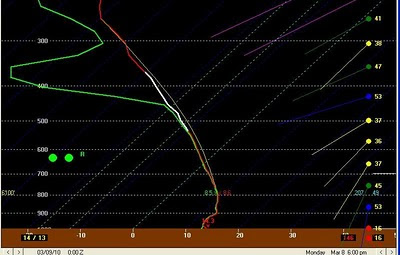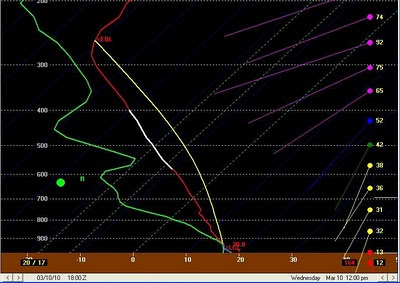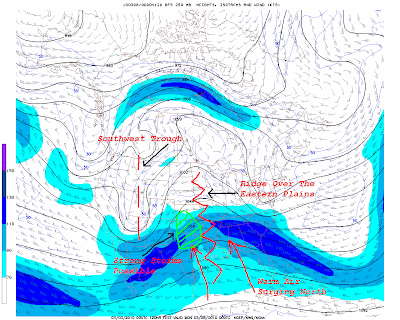A strong storm system is moving across the Southwest United States this afternoon and will set the stage for rain and thunderstorms across East Texas Monday. The big question this time of the year is will we see any severe weather with this system. Right now it looks as though there is a Chance of a few strong thunderstorms but a lack of moisture may keep things from getting too out of hand. Yesterdays mid range forecast data showed there is a chance of severe storms across East Texas Monday. As we get closer to the event, forecast models are still suppressing the moisture necessary for severe surface based convection, the storms that can produce tornadoes. The image below show the forecast dewpoint temperatures Monday evening as the storms move through. The brighter green indicated the 50 degree dewpoint. We would normally need to see dewpoints in the low 60s to start introducing a tornado threat with this type of set up. I still feel models are underestimating the dewpoint temperatures but I have my doubts on low 60 dewpoints making it up to I-20.

However, there will be plenty of forcing to help with in elevated convection so I do think we will see a few strong, possible severe storms with hail being the main threat. The image below shows vorticity at 500mb. We can see a negative tilted vort max moving through the area. this will aid in rising air parcels which could lead to thunderstorms.

We can also see that by the image below East Texas will be in the left front quadrant of a jet streak. This too will aid in lift helping to form thunderstorms.

Monday's event is starting to look more like a heavy rain event than a major severe weather threat. Again, if higher dewpoints move into the area, the threat of severe weather will increase. The available shear will help make any thunderstorm become supercellular and if this storm is able to ingest surface based instability, there is enough low level turning with height of the winds to where tornadoes would be a concern.
Another storm system will be moving towards East Texas quickly on the heels of Monday's system. There are some differences in the mid range forecast models so I will point out the "worst case" scenario from the GFS. Notice in the image below the dewpoints are much higher than with Monday's system. They do approach the 60 degree mark increasing the threat for tornadoes.

The image below shows the forecast sounding for Wednesday afternoon. You can see that there is over 1000 J/kg of CAPE, plenty of buoyancy for thunderstorm development this time of the year. Another concern is the location of the LCL, lifted condensation level. The is normally where we would find the cloud base in thunderstorm development. The LCL is less than 800 feel above ground level, very low and very conducive for tornadoes.

Now that we can see we will have rising air, what will be occurring in that column of rising air. By looking at the hodograph below you can clearly see a large clockwise turning of the wind with height. This is very conducive to tornado development.

Now the difference between the LCL and LFC, level of free convection, is around 3000 feet. But if you look at the images below you can see there is other areas of forcing to help rise that air from the LCL to the LFC.

Both the 500mb vorticity and jet stream look very similar to Monday's event. So we will have added lift to help generate storms.

The amount of bulk shear Wednesday is forecast to be over 50 knots as well which will promote supercellular structure. The possible difference between Monday and Wednesday is on Wednesday storms should be routed in the surface layer meaning there is a threat of tornadoes. I will also state that the European forecast model keeps the area of low pressure along the Gulf Coast keeping surface based storms well to our south basically eliminating the tornado threat. We will have to monitor these developing systems very closely over the weekend.



































